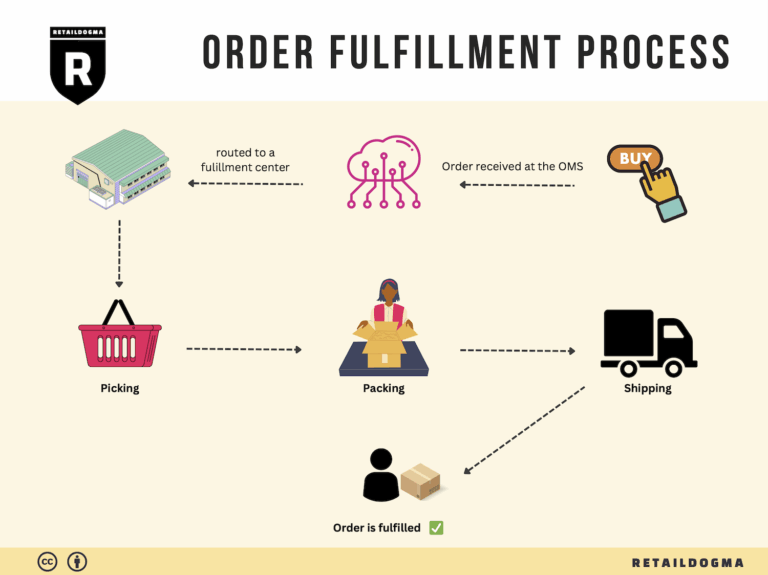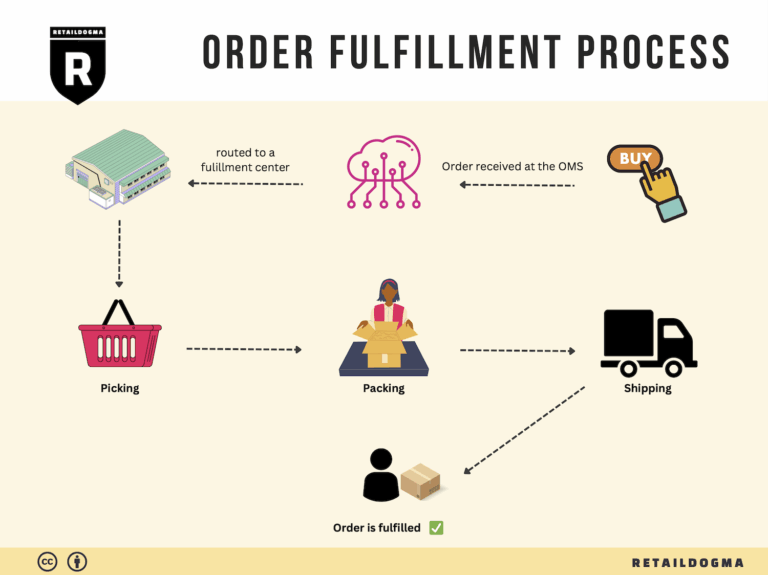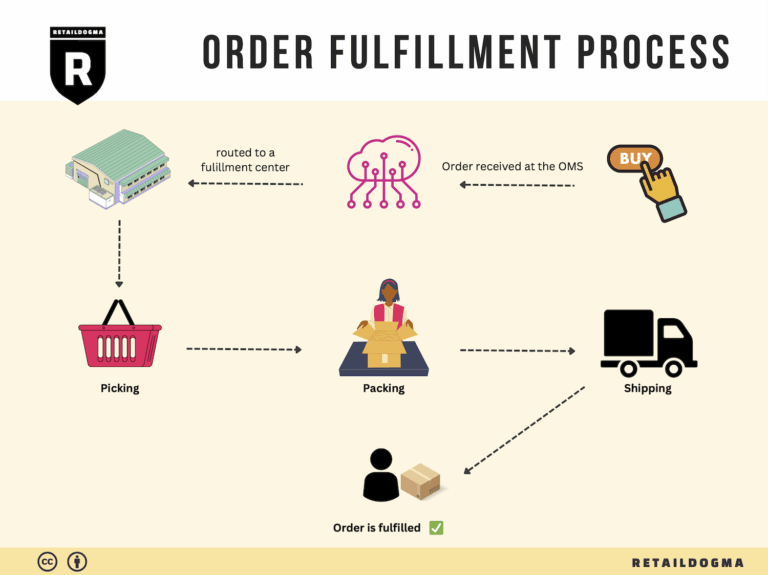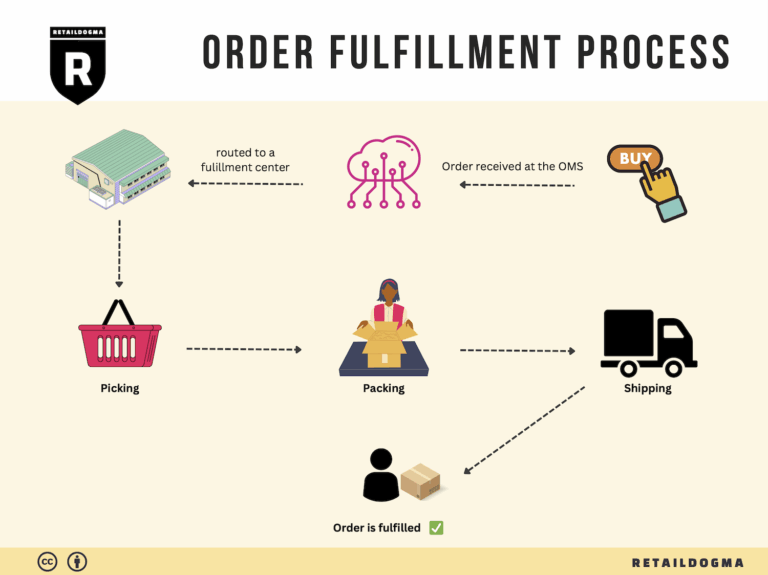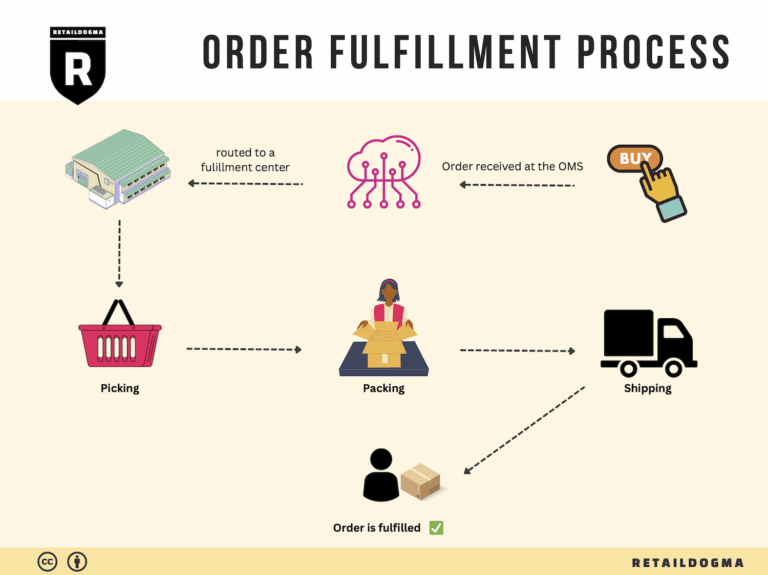How Order Fulfillment Works: A Step-by-Step Guide for Businesses
What is E-commerce Fulfillment? An Introduction for Growing Businesses
As online businesses scale, many owners find themselves overwhelmed by the complexities of packing and shipping orders. What once seemed manageable can quickly become a daunting task, consuming precious time and resources. This is where e-commerce fulfillment comes into play. Simply put, fulfillment is the comprehensive process of getting a product from your inventory to the hands of your customer. It encompasses everything from inventory management and order processing to packing, shipping, and handling returns.
In this guide, we will delve into the various fulfillment models available for growing businesses. You’ll learn about third-party logistics (3PL) providers, which can take the burden of order fulfillment off your shoulders, and Fulfillment by Amazon (FBA), a popular choice for many e-commerce sellers looking to leverage Amazon’s vast logistics network. Understanding these models is crucial as they can significantly impact your operational efficiency and customer satisfaction.
We will also explore the core services associated with e-commerce fulfillment. These services typically include inventory storage, order picking and packing, shipping, and returns processing. Each service plays a vital role in ensuring that your customers receive their orders promptly and accurately, which is essential for maintaining a positive brand reputation and encouraging repeat business.
Choosing the right fulfillment partner can make or break your business’s logistics strategy. This guide will provide you with practical tips on what to look for in a fulfillment partner, such as their technology capabilities, shipping speed, customer service, and pricing structures. We will help you understand how to evaluate potential partners to ensure they align with your business goals and customer expectations.
Finally, we will discuss pricing considerations in the realm of e-commerce fulfillment. Understanding the cost implications of different fulfillment options is key to making informed decisions that can enhance your profitability. From storage fees to shipping costs, we will break down the factors that influence pricing and offer strategies for managing these expenses effectively.
The ultimate goal of this guide is to empower you—business owners, operations managers, and entrepreneurs—to make informed decisions about your logistics strategy. By understanding the nuances of e-commerce fulfillment, you can streamline your operations, enhance customer satisfaction, and drive growth in your online business.
What You’ll Learn In This Guide
- What is E-commerce Fulfillment? An Introduction for Growing Businesses
- The Order Fulfillment Process: From ‘Buy’ Button to Customer’s Door
- Comparing Fulfillment Models: In-House vs. 3PL vs. Dropshipping
- A Deep Dive into Amazon FBA: Pros, Cons, and Who It’s For
- Core Services Offered by Fulfillment Centers
- How to Choose a Fulfillment Partner: A 6-Point Checklist
- Understanding Fulfillment Pricing: A Breakdown of Common Fees
- Frequently Asked Questions (FAQs) about Fulfillment
- Conclusion: Is Outsourcing Fulfillment the Right Move for Your Business?
- Important Disclaimer
The Order Fulfillment Process: From ‘Buy’ Button to Customer’s Door
1. Receiving Inventory
The first step in the order fulfillment process is receiving inventory. This involves the arrival of products at the fulfillment center, such as Amazon’s RFD4 in Huntley, IL. Upon arrival, each shipment is checked against purchase orders to ensure accuracy. This step is crucial as it sets the foundation for efficient inventory management and order processing.
Importance: Properly receiving inventory minimizes discrepancies and errors that could lead to stockouts or overstock situations. An effective receiving process can enhance inventory accuracy, ensuring that products are available when customers place orders.
Key Term: SKU (Stock Keeping Unit) – Each product is assigned a unique SKU to facilitate tracking and management within the warehouse.
2. Warehouse Storage
Once inventory is received and verified, the next step is warehouse storage. Products are organized and placed in designated storage areas within the fulfillment center. This can involve shelving, pallet racking, or automated storage systems, depending on the warehouse’s size and complexity.
Importance: Efficient warehouse storage maximizes space utilization and makes it easier to locate products. A well-organized storage system reduces the time required to find and pick items during the order fulfillment process, ultimately improving order processing speed.
Key Term: ABC Analysis – This inventory categorization technique helps prioritize items based on their sales volume and value, ensuring that high-demand products are easily accessible.
3. Order Picking
Order picking is the process of retrieving products from storage to fulfill customer orders. Once an order is placed, a pick list is generated, detailing the items and their locations within the warehouse. Workers then use this list to gather the necessary products.
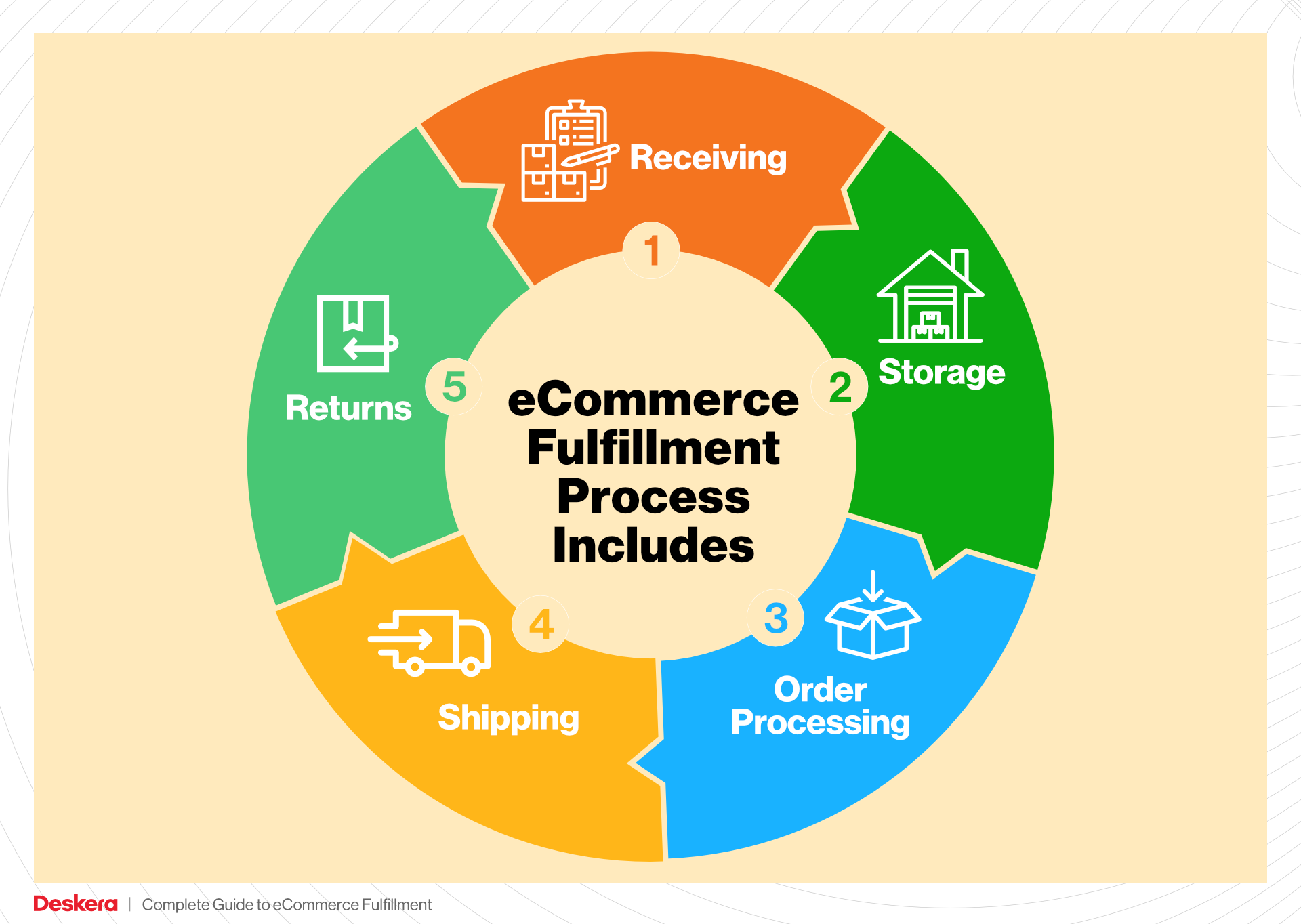
Importance: This step is critical for ensuring that orders are accurate and complete. Efficient picking processes can significantly reduce order lead times, which is essential for maintaining customer satisfaction and trust.
Key Term: Pick Lists – These lists guide warehouse staff in selecting the correct items for each order, ensuring accuracy and efficiency in the picking process.
4. Order Packing
After items are picked, they move to the packing stage. Here, products are carefully packed into boxes or containers, often using protective materials to prevent damage during transit. Additionally, packing slips and shipping labels are prepared and attached to the packages.
Importance: Proper packing not only protects products but also helps streamline the shipping process. A well-packed order ensures that items arrive at the customer’s location in perfect condition, which is vital for customer satisfaction and reducing return rates.
Key Term: Packing Slip – This document is included in the package, detailing the items included in the shipment, which helps customers verify their orders upon receipt.
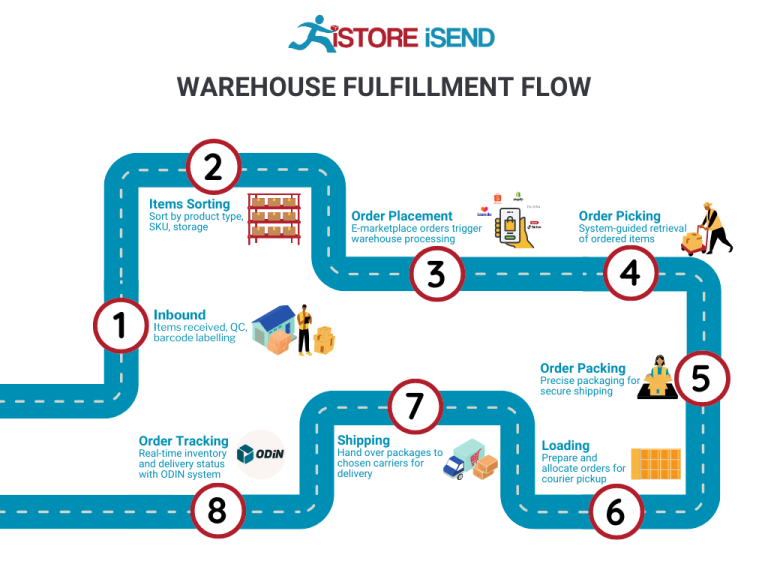
5. Shipping & Delivery
The final step in the order fulfillment process is shipping and delivery. Once the order is packed, it is handed off to a carrier for transportation to the customer. Depending on the shipping method chosen by the customer, delivery can occur within days or even hours.
Importance: The shipping and delivery stage is the culmination of the entire fulfillment process. It directly impacts customer satisfaction and loyalty. Fast and reliable shipping options can set a business apart from competitors and encourage repeat purchases.
Key Term: Last Mile Delivery – This term refers to the final step of the delivery process, where the package is transported from a distribution center to the customer’s doorstep. It’s a critical component of customer experience in e-commerce.
In conclusion, understanding and optimizing each step of the order fulfillment process—from receiving inventory to the final delivery—can significantly enhance operational efficiency and customer satisfaction. For e-commerce businesses looking to scale, investing in technology and best practices for these processes is essential for sustained growth and competitiveness in the marketplace.
Comparing Fulfillment Models: In-House vs. 3PL vs. Dropshipping
Fulfillment Model Comparison Table
| Model | Who Handles Inventory | Best For (Business Stage) | Key Advantage | Key Disadvantage |
|---|---|---|---|---|
| In-House Fulfillment | Business itself | Established businesses with steady sales | Complete control over inventory and operations | High overhead costs and resource demands |
| Third-Party Logistics (3PL) | Third-party provider | Growing businesses looking to scale quickly | Cost-effective scalability and expertise | Less control over inventory and processes |
| Dropshipping | Supplier | Startups and small businesses | Low upfront costs and minimal risk | Lower profit margins and less control over fulfillment |
In-House Fulfillment
In-house fulfillment involves managing all aspects of inventory and order processing within the business itself. This model is typically adopted by established businesses that have a stable sales volume and sufficient resources to handle logistics. The key advantage of in-house fulfillment is the complete control it offers over inventory management, order processing, and customer service. Businesses can customize their fulfillment processes to meet specific needs and maintain a high level of quality control.
However, this model comes with significant disadvantages. High overhead costs associated with warehousing, staffing, and technology can strain financial resources. Additionally, in-house fulfillment requires considerable time and expertise to manage effectively. As a business grows, scaling operations can become increasingly complex, often leading to logistical challenges and inefficiencies if not managed correctly. Businesses must weigh the benefits of control against the financial and operational demands of maintaining in-house fulfillment.
Third-Party Logistics (3PL)
Third-party logistics (3PL) providers take on the responsibility of inventory storage, order fulfillment, and shipping on behalf of businesses. This model is ideal for growing companies looking to scale their operations quickly without the burden of managing logistics themselves. The key advantage of 3PL is cost-effective scalability. Businesses can leverage the expertise of 3PL providers who specialize in logistics, allowing them to focus on core competencies such as marketing and product development.
However, the reliance on a third party can lead to a loss of control over inventory and fulfillment processes. Communication issues can arise, potentially impacting order accuracy and customer satisfaction. Additionally, businesses may face challenges if the 3PL provider does not align with their operational goals or customer service standards. Careful selection of a reputable 3PL partner is crucial for mitigating these risks and ensuring that the logistics operation runs smoothly.
Dropshipping
Dropshipping is a fulfillment model where the retailer does not keep products in stock. Instead, when a customer makes a purchase, the retailer purchases the item from a third party (usually a wholesaler or manufacturer) who ships it directly to the customer. This model is particularly well-suited for startups and small businesses with limited capital and resources. The primary advantage of dropshipping is the low upfront costs and minimal financial risk, as there is no need to invest in inventory upfront.
However, dropshipping comes with its own set of challenges. Profit margins can be lower compared to other fulfillment models, as retailers often pay wholesale prices and must account for shipping costs. Additionally, businesses have less control over the fulfillment process, including shipping times and product quality, which can lead to customer dissatisfaction. In a highly competitive e-commerce landscape, relying on dropshipping requires careful selection of suppliers and effective management of customer expectations to ensure a positive shopping experience.

Conclusion
Choosing the right fulfillment model is critical for the success and scalability of an e-commerce business. Each model—In-house fulfillment, Third-Party Logistics, and Dropshipping—offers unique advantages and disadvantages that must be carefully considered in light of the company’s stage, resources, and strategic goals. As businesses grow and evolve, their fulfillment strategies may also need to adapt to meet changing demands and market conditions. By understanding these models and their implications, business owners can make informed decisions that align with their operational needs and long-term objectives.
A Deep Dive into Amazon FBA: Pros, Cons, and Who It’s For
What is Fulfillment by Amazon (FBA)?
Fulfillment by Amazon (FBA) is a service provided by Amazon that allows sellers to store their products in Amazon’s fulfillment centers. Amazon takes care of storage, packaging, and shipping of the products, as well as customer service and returns. This service is designed to simplify the logistics of selling online, enabling sellers to focus on other aspects of their business, such as marketing and product development.
When a customer places an order for an FBA product, Amazon picks, packs, and ships the item directly to the customer. This not only streamlines the order fulfillment process but also allows sellers to leverage Amazon’s robust logistics infrastructure, including their extensive shipping network, which often results in faster delivery times.
How FBA Works
-
Create an Amazon Seller Account: To start using FBA, sellers must first create an Amazon Seller account. They can choose between an Individual or Professional selling plan, depending on their sales volume.
-
Prepare Products for Shipment: Sellers prepare their products according to Amazon’s guidelines, which include labeling, packaging, and ensuring that the products meet Amazon’s quality standards.
-
Ship Products to Amazon: Sellers then ship their products to Amazon’s fulfillment centers. Amazon provides recommendations on which fulfillment center to use based on the seller’s location and the products being sent.
-
Storage and Inventory Management: Once received, products are stored in Amazon’s warehouses. Sellers can manage their inventory through the Amazon Seller Central dashboard, where they can track stock levels and sales.
-
Order Fulfillment: When a customer orders a product, Amazon handles the entire fulfillment process, including picking, packing, and shipping. Products fulfilled by Amazon are also eligible for Amazon Prime, which can enhance visibility and sales potential.
-
Customer Service and Returns: Amazon manages customer service for FBA products, including processing returns and handling customer inquiries. This allows sellers to provide a consistent customer experience without needing to manage these interactions themselves.
Pros of FBA
Prime Eligibility
One of the most significant advantages of using FBA is that products become eligible for Amazon Prime. This can lead to increased sales as Prime members tend to prefer items that offer free two-day shipping.
Customer Trust
Sellers benefit from the trust associated with the Amazon brand. Customers often feel more secure purchasing from FBA sellers due to Amazon’s reputation for reliability and customer service.
Multi-Channel Fulfillment
FBA supports multi-channel fulfillment, meaning sellers can use Amazon’s logistics services to fulfill orders from other sales channels, such as their own websites or other marketplaces. This can simplify logistics and help streamline operations.
Scalability
FBA allows sellers to scale their businesses without the need for extensive warehousing or logistics capabilities. As demand grows, sellers can send more inventory to Amazon without needing to invest in their fulfillment infrastructure.
Time Savings
By outsourcing fulfillment to Amazon, sellers can save significant time on logistics, allowing them to focus on marketing, product development, and other critical business areas.
Cons of FBA
High Fees
FBA comes with various fees, including storage fees for products stored in Amazon’s warehouses and fulfillment fees for each item sold. For sellers with low margins or high inventory turnover, these costs can significantly impact profitability.
Strict Inventory Rules
Amazon imposes strict inventory management rules, including requirements for labeling and packaging. Sellers must adhere to these rules or risk penalties, including additional fees or removal of inventory.
Commingling Risks
FBA products may be commingled, meaning that sellers’ products are stored alongside those of other sellers. This can pose risks in terms of quality control and brand integrity, especially if a customer receives a defective or unsatisfactory item that is not representative of the seller’s brand.
Limited Control
By using FBA, sellers relinquish some control over their fulfillment process. This can be problematic in situations where sellers want to customize packaging or provide a unique unboxing experience for their customers.
Inventory Management Challenges
While FBA simplifies order fulfillment, it can complicate inventory management. Sellers must keep track of their inventory levels at Amazon’s warehouses and manage reorders carefully to avoid stockouts or excess storage fees.
Who is FBA Best For?
Fulfillment by Amazon is particularly well-suited for:
-
Small to Medium-Sized Businesses: Companies that lack the resources to establish their own logistics and fulfillment infrastructure can benefit significantly from Amazon’s services.
-
E-commerce Entrepreneurs: Individuals looking to start an online store can leverage FBA to reduce the complexities of order fulfillment, allowing them to focus on growing their business.
-
Sellers with High Sales Volume: Businesses that experience high sales volume can take advantage of Amazon’s logistics capabilities to manage large inventories and fulfill orders efficiently.
-
Brands Seeking Visibility: Sellers looking to increase their product visibility and sales through Amazon’s platform, particularly those wanting to tap into the Prime customer base.
In conclusion, while FBA offers numerous advantages that can aid in scaling an e-commerce business, it is essential for sellers to weigh these against the potential downsides, particularly in terms of fees and control. Understanding the nuances of FBA will enable business owners to make informed decisions that align with their growth strategies.
Core Services Offered by Fulfillment Centers
Inventory Management & Warehousing
Effective inventory management and warehousing are fundamental services provided by fulfillment centers. This process involves the systematic tracking and control of inventory levels, ensuring that stock is available when needed without overstocking.
What It Is: Fulfillment centers utilize advanced inventory management systems to monitor stock levels in real-time. These systems can provide insights into inventory turnover rates, predict future stock needs based on sales trends, and automate reordering processes. Warehousing services include secure storage solutions for products, ensuring they are organized and easily accessible.
Benefits to E-commerce Businesses:
– Reduced Costs: By optimizing inventory levels, businesses can minimize storage costs and reduce the risk of obsolescence.
– Increased Efficiency: Automated inventory tracking can streamline operations, allowing businesses to focus on growth strategies instead of manual inventory checks.
– Improved Customer Satisfaction: With accurate inventory levels, businesses can fulfill orders more quickly and reliably, leading to higher customer satisfaction and loyalty.
Pick and Pack Services
Pick and pack services involve the process of selecting items from inventory (picking) and preparing them for shipment (packing). This is a critical component of order fulfillment that directly affects delivery speed and accuracy.
What It Is: Fulfillment centers employ trained staff or automated systems to efficiently pick the right products based on customer orders. Once picked, items are carefully packed using appropriate materials to ensure they arrive undamaged. This service may also include labeling and documentation necessary for shipping.
Benefits to E-commerce Businesses:
– Faster Order Processing: Streamlined pick and pack processes can significantly reduce the time from order placement to dispatch, enabling faster delivery to customers.
– Accuracy: With dedicated systems in place, the likelihood of errors in order fulfillment decreases, minimizing returns and improving customer trust.
– Scalability: As a business grows, fulfillment centers can easily scale their pick and pack operations to meet increased demand without requiring additional resources from the business.
Kitting and Assembly
Kitting and assembly services involve the grouping of various products into a single kit or the assembly of products before shipping. This service is particularly beneficial for businesses that sell products that require assembly or bundling for promotional purposes.
What It Is: In kitting, individual items are combined into a pre-packaged set, which is then shipped as a single unit. Assembly services may involve the construction of products or the addition of components that customers need to use the product effectively.
Benefits to E-commerce Businesses:
– Enhanced Product Offering: By offering kits or assembled products, businesses can create unique value propositions that differentiate them from competitors.
– Cost Efficiency: Kitting can reduce shipping costs by consolidating multiple items into one package, which can also simplify inventory management.
– Improved Customer Experience: Customers appreciate receiving complete solutions, which can lead to higher satisfaction and reduced returns.
Returns Management (Reverse Logistics)
Returns management, or reverse logistics, refers to the process of handling product returns from customers. This service is crucial for maintaining customer satisfaction and managing inventory effectively.
What It Is: Fulfillment centers implement efficient returns management systems that handle the return of products, assess their condition, restock items if possible, and manage any necessary refurbishments. This process often includes automated return labels and tracking for customer convenience.
Benefits to E-commerce Businesses:
– Streamlined Processes: An efficient returns management system can significantly reduce the time and labor involved in processing returns, allowing businesses to reallocate resources to growth initiatives.
– Customer Retention: A hassle-free return process enhances customer trust and can lead to repeat business, as customers are more likely to purchase from retailers that offer easy returns.
– Data Insights: Analyzing return data can provide valuable insights into product quality and customer preferences, enabling businesses to make informed decisions about inventory and product offerings.
By leveraging these core services offered by fulfillment centers, e-commerce businesses can optimize their operations, enhance customer satisfaction, and ultimately drive growth. Each of these services plays a vital role in creating a seamless logistics process that supports scaling and efficiency.
How to Choose a Fulfillment Partner: A 6-Point Checklist
Location & Warehouse Network
Importance:
The geographical location of your fulfillment partner’s warehouses can significantly impact shipping costs and delivery times. A partner with strategically located warehouses can help you reach a larger customer base more efficiently.
Questions to Ask:
– Where are your warehouses located, and how does that align with my target market?
– What is your average shipping time to key markets?
– Do you have facilities in regions that can support my growth plans?
Technology & Integrations
Importance:
An efficient fulfillment operation relies heavily on technology. The right systems can streamline inventory management, order processing, and shipping. Additionally, integrations with your existing e-commerce platform are crucial for real-time data sharing.
Questions to Ask:
– What technology platforms do you use for order management and inventory tracking?
– Can your systems integrate with my e-commerce platform (e.g., Shopify, WooCommerce, Amazon)?
– Do you offer API access for custom integrations?
Specializations (e.g., cold storage, oversized items)
Importance:
Depending on your product offerings, you may need a fulfillment partner with specific capabilities. For instance, if you sell perishable goods, cold storage is essential. If your products are oversized or require special handling, ensure your partner has the necessary infrastructure.
Questions to Ask:
– What types of products do you specialize in handling?
– Do you have facilities for temperature-sensitive items or oversized goods?
– Can you accommodate unique packaging or labeling requirements?
Scalability & Capacity
Importance:
As your business grows, your fulfillment needs will evolve. Partnering with a provider that can scale with your business will save you from the headaches of switching providers or infrastructure limitations.
Questions to Ask:
– What is your current capacity, and how have you scaled in the past?
– How do you handle peak seasons or unexpected spikes in order volume?
– Are there limits to the types of products or volumes you can manage?
Pricing and Contracts
Importance:
Understanding the pricing structure is critical to ensuring that your fulfillment costs align with your budget and business model. Transparent pricing helps avoid hidden fees that can erode your margins.
Questions to Ask:
– What is your pricing structure (e.g., per order, per item, monthly fees)?
– Are there additional costs for services such as returns processing, special packaging, or inventory storage?
– What are the terms of the contract, and is there flexibility for renegotiation as my business needs change?
Customer Support & Reviews
Importance:
Reliable customer support is vital for addressing issues as they arise and ensuring smooth operations. Additionally, researching customer reviews can provide insight into the partner’s reputation and reliability.
Questions to Ask:
– What level of customer support can I expect (e.g., dedicated account manager, 24/7 support)?
– How do you handle order discrepancies or customer complaints?
– Can you provide references or case studies from current or past clients?
Conclusion
Choosing the right fulfillment partner is a crucial decision that can affect your business’s operational efficiency and customer satisfaction. By considering these six key areas—location and warehouse network, technology and integrations, specializations, scalability and capacity, pricing and contracts, and customer support—you can make an informed decision that aligns with your business goals. Always conduct thorough due diligence, and don’t hesitate to ask for detailed information to ensure that your chosen partner can meet your current and future needs.
Understanding Fulfillment Pricing: A Breakdown of Common Fees
Initial Setup Fees
When partnering with a fulfillment center like Amazon RFD4, businesses often encounter initial setup fees. These fees cover the administrative costs associated with onboarding a new client. Typically, initial setup fees can range from a few hundred to several thousand dollars, depending on the complexity of the services required.
Calculation Method: Initial setup fees are usually a flat rate that varies based on the level of integration needed with your existing systems, the number of products being listed, and the extent of customization required for your fulfillment process. It’s essential to ask for a detailed breakdown of what this fee includes to avoid any surprises.
Receiving Fees
Receiving fees apply when your inventory arrives at the fulfillment center. These fees cover the costs associated with unloading, inspecting, and storing your products before they are put into inventory.
Calculation Method: Receiving fees are often charged per pallet or per item. For example, a fulfillment center may charge $25 per pallet or $0.50 per item received. The total cost will depend on the volume of inventory being sent to the warehouse. It’s wise to have your shipment organized and labeled properly to minimize receiving errors, which can incur additional costs.
Storage Fees (per pallet/bin)
Storage fees are incurred for keeping your products in the fulfillment center. These fees can be calculated on a monthly basis and are typically based on the space your inventory occupies, either by pallet or by bin.
Calculation Method: Storage fees can vary significantly by location and time of year. For instance, some centers may charge $15 to $30 per pallet per month. Additionally, businesses should be aware that some fulfillment centers implement seasonal pricing, where fees may increase during peak seasons like the holidays. It’s crucial to monitor your inventory turnover to avoid excessive storage fees for slow-moving products.
Pick & Pack Fees (per item/order)
Pick and pack fees are charged for the labor involved in selecting items from inventory and preparing them for shipment. This fee is crucial to understand, as it directly impacts the overall cost of fulfilling orders.
Calculation Method: These fees are generally calculated per item or per order. For example, a fulfillment center might charge $1.00 per item picked and packed. If an order includes five items, the total pick and pack fee would be $5.00. Some centers may offer tiered pricing, where the fee decreases as order volume increases, providing an incentive for businesses with higher sales volumes.
Shipping Fees
Shipping fees encompass the costs associated with transporting your products from the fulfillment center to the customer. These fees can vary widely based on the shipping method chosen, the destination, and the weight and dimensions of the package.
Calculation Method: Shipping fees are typically determined by the carrier’s pricing structure, which can include factors such as distance, weight, and shipping speed. For instance, standard ground shipping may cost significantly less than expedited shipping. Fulfillment centers often have negotiated rates with carriers, which can help reduce shipping costs for businesses. It’s advisable to discuss shipping options and any potential discounts available through the fulfillment center.
Tips for Getting an Accurate Quote
To ensure you receive an accurate quote from a fulfillment center like Amazon RFD4, consider the following tips:
-
Be Transparent About Your Needs: Provide detailed information about your product range, anticipated order volume, and any specific requirements you may have. This transparency helps fulfillment centers tailor their services and pricing to your business.
-
Request Itemized Quotes: Ask for a detailed breakdown of all fees involved. An itemized quote allows you to understand the costs associated with each service and helps identify any potential hidden fees.
-
Compare Multiple Providers: Don’t settle for the first quote you receive. Comparing several fulfillment centers can provide insights into pricing norms and help you negotiate better terms.
-
Inquire About Discounts: Ask about bulk shipping discounts or loyalty programs that may lower your overall costs. Many fulfillment centers offer incentives for businesses that commit to long-term contracts or have high shipping volumes.
-
Factor in Hidden Costs: Be aware of potential additional costs, such as returns processing fees or inventory management fees. Clarifying these aspects upfront can prevent budget overruns later.
By understanding these common fulfillment pricing models and employing strategic inquiry, e-commerce businesses can optimize their logistics costs and enhance their operational efficiency.
Frequently Asked Questions (FAQs) about Fulfillment
1. What is Amazon Fulfillment Center RFD4?
Amazon Fulfillment Center RFD4 is a state-of-the-art warehouse facility located at 11400 Venture Ct, Huntley, IL. This center covers a total area of 1,160,150 square feet and is designed to streamline the storage and distribution of goods for Amazon sellers, facilitating faster shipping and efficient inventory management.
2. How does fulfillment work at Amazon RFD4?
At Amazon RFD4, fulfillment involves receiving, storing, picking, packing, and shipping products on behalf of sellers. When a customer places an order, the fulfillment center picks the item from storage, packs it, and ships it directly to the customer, leveraging Amazon’s logistics network to ensure timely delivery.
3. What are the key benefits of using Amazon RFD4 for my business?
Using Amazon RFD4 offers numerous benefits, including:
– Faster shipping times due to its strategic location.
– Access to Amazon’s vast logistics network, ensuring reliable delivery options.
– Scalability to accommodate growing inventory and order volumes.
– Reduced operational overhead, allowing sellers to focus on other areas of their business.
4. What’s the difference between a warehouse and a fulfillment center?
While both warehouses and fulfillment centers store goods, their functions differ significantly. A warehouse primarily focuses on storing inventory for long periods, while a fulfillment center is designed for order processing, including picking, packing, and shipping products directly to customers. Fulfillment centers often integrate advanced technology and logistics services to enhance efficiency.
5. What is a Third-Party Logistics Provider (3PL)?
A Third-Party Logistics Provider (3PL) is a company that offers outsourced logistics services to businesses. This includes warehousing, fulfillment, transportation, and distribution. By partnering with a 3PL, businesses can streamline their supply chain operations, reduce costs, and focus on their core competencies.
6. How much do fulfillment services cost at Amazon RFD4?
The cost of fulfillment services at Amazon RFD4 varies based on several factors, including the size and weight of the products, storage duration, and the specific services utilized (e.g., packing, shipping). Typically, sellers pay a per-unit fee for fulfillment, along with additional charges for storage and optional services. It’s advisable to review Amazon’s FBA pricing guidelines for precise costs.
7. What types of products can be fulfilled through Amazon RFD4?
Amazon RFD4 can handle a wide variety of products, including consumer electronics, apparel, household items, and more. However, there are restrictions on certain categories, such as hazardous materials or perishables. Sellers should refer to Amazon’s guidelines to ensure compliance with product eligibility.
8. How can I track my inventory at Amazon RFD4?
Sellers can track their inventory at Amazon RFD4 through the Amazon Seller Central platform. This online dashboard provides real-time updates on stock levels, order status, and fulfillment performance, enabling sellers to manage their inventory efficiently.
9. What are the requirements for using Amazon RFD4?
To use Amazon RFD4, sellers must enroll in Amazon’s Fulfillment by Amazon (FBA) program. This includes creating a seller account, listing products on Amazon, and preparing items for shipment to the fulfillment center according to Amazon’s packaging and labeling guidelines.
10. Can I use Amazon RFD4 for international shipping?
Yes, Amazon RFD4 supports international shipping through Amazon’s global logistics network. Sellers can offer their products to customers in various countries, but they should be aware of the associated shipping costs, customs regulations, and potential delays involved in international fulfillment.
Conclusion: Is Outsourcing Fulfillment the Right Move for Your Business?
Evaluating the Benefits of Outsourcing Fulfillment
Outsourcing fulfillment can be a transformative decision for e-commerce businesses looking to scale. One of the most significant advantages is time savings. By delegating warehousing, packing, and shipping tasks to a specialized fulfillment center, business owners can focus on core activities such as product development, marketing, and customer engagement. This shift not only enhances operational efficiency but also allows for more strategic allocation of resources.
Another key benefit is scalability. As your business grows, so do your fulfillment needs. A reliable fulfillment partner can seamlessly adapt to fluctuations in order volume, whether during seasonal spikes or unexpected surges in demand. This flexibility ensures that your customers receive their orders promptly, which is crucial for maintaining high satisfaction levels and fostering repeat business.
Moreover, partnering with an experienced fulfillment service provides access to industry expertise and advanced technology. These partners often leverage sophisticated inventory management systems and logistics solutions that can optimize shipping routes and reduce costs. Their established relationships with carriers can also lead to better shipping rates, which can improve your bottom line.
However, the decision to outsource fulfillment should not be taken lightly. Choosing the right partner is critical for sustainable growth. Conduct thorough research, assess potential partners’ capabilities, and consider their track record with businesses similar to yours.
Call to Action
Take a moment to audit your current shipping and fulfillment processes. Are they efficient and scalable? If you find gaps or inefficiencies, it may be time to explore fulfillment partnerships that align with your business goals. Making the right choice now can set the foundation for future success and growth.
Important Disclaimer
⚠️ Important Disclaimer
The information in this guide is for educational purposes. Fulfillment services, pricing, and platform features change frequently. Always conduct your own due diligence and consult with providers directly before making business decisions.

